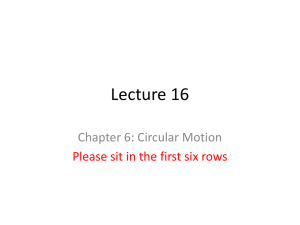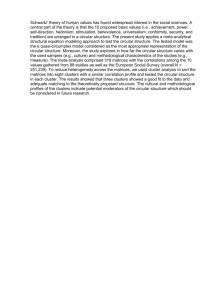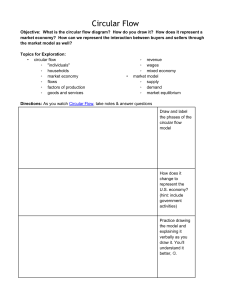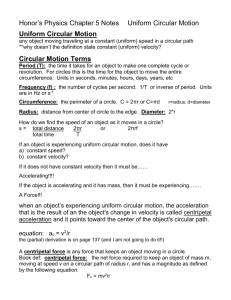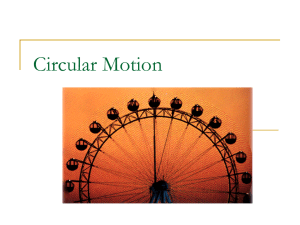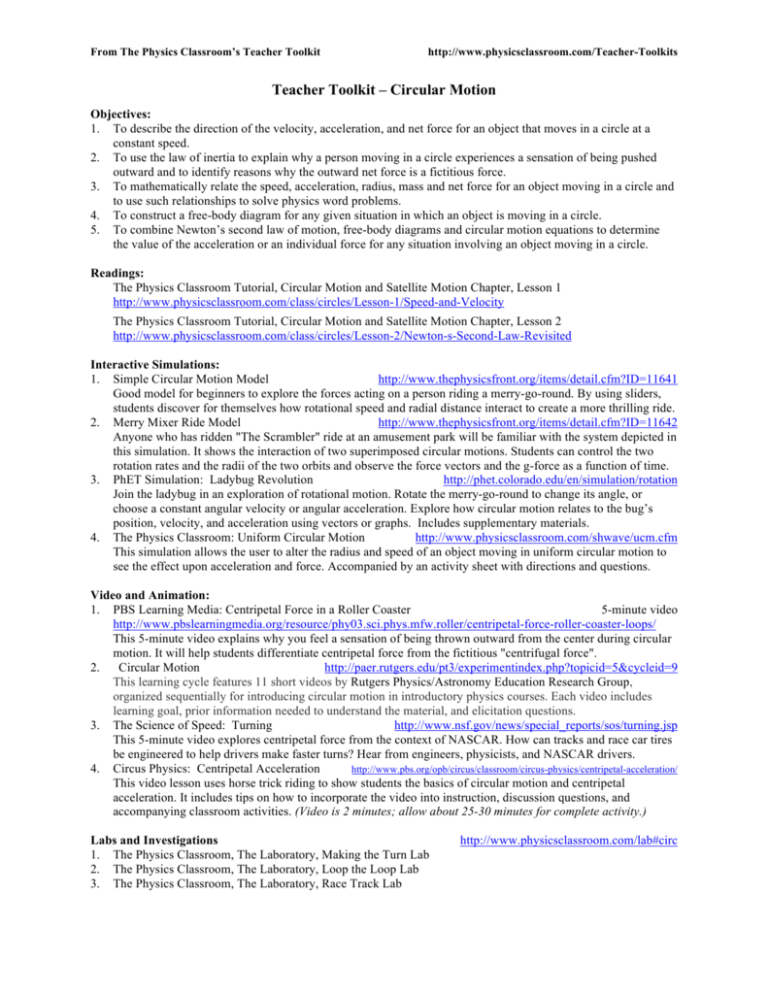
From The Physics Classroom’s Teacher Toolkit
http://www.physicsclassroom.com/Teacher-Toolkits
Teacher Toolkit – Circular Motion
Objectives:
1. To describe the direction of the velocity, acceleration, and net force for an object that moves in a circle at a
constant speed.
2. To use the law of inertia to explain why a person moving in a circle experiences a sensation of being pushed
outward and to identify reasons why the outward net force is a fictitious force.
3. To mathematically relate the speed, acceleration, radius, mass and net force for an object moving in a circle and
to use such relationships to solve physics word problems.
4. To construct a free-body diagram for any given situation in which an object is moving in a circle.
5. To combine Newton’s second law of motion, free-body diagrams and circular motion equations to determine
the value of the acceleration or an individual force for any situation involving an object moving in a circle.
Readings:
The Physics Classroom Tutorial, Circular Motion and Satellite Motion Chapter, Lesson 1
http://www.physicsclassroom.com/class/circles/Lesson-1/Speed-and-Velocity
The Physics Classroom Tutorial, Circular Motion and Satellite Motion Chapter, Lesson 2
http://www.physicsclassroom.com/class/circles/Lesson-2/Newton-s-Second-Law-Revisited
Interactive Simulations:
1. Simple Circular Motion Model
http://www.thephysicsfront.org/items/detail.cfm?ID=11641
Good model for beginners to explore the forces acting on a person riding a merry-go-round. By using sliders,
students discover for themselves how rotational speed and radial distance interact to create a more thrilling ride.
2. Merry Mixer Ride Model
http://www.thephysicsfront.org/items/detail.cfm?ID=11642
Anyone who has ridden "The Scrambler" ride at an amusement park will be familiar with the system depicted in
this simulation. It shows the interaction of two superimposed circular motions. Students can control the two
rotation rates and the radii of the two orbits and observe the force vectors and the g-force as a function of time.
3. PhET Simulation: Ladybug Revolution
http://phet.colorado.edu/en/simulation/rotation
Join the ladybug in an exploration of rotational motion. Rotate the merry-go-round to change its angle, or
choose a constant angular velocity or angular acceleration. Explore how circular motion relates to the bug’s
position, velocity, and acceleration using vectors or graphs. Includes supplementary materials.
4. The Physics Classroom: Uniform Circular Motion
http://www.physicsclassroom.com/shwave/ucm.cfm
This simulation allows the user to alter the radius and speed of an object moving in uniform circular motion to
see the effect upon acceleration and force. Accompanied by an activity sheet with directions and questions.
Video and Animation:
1. PBS Learning Media: Centripetal Force in a Roller Coaster
5-minute video
http://www.pbslearningmedia.org/resource/phy03.sci.phys.mfw.roller/centripetal-force-roller-coaster-loops/
This 5-minute video explains why you feel a sensation of being thrown outward from the center during circular
motion. It will help students differentiate centripetal force from the fictitious "centrifugal force".
2.
Circular Motion
http://paer.rutgers.edu/pt3/experimentindex.php?topicid=5&cycleid=9
This learning cycle features 11 short videos by Rutgers Physics/Astronomy Education Research Group,
organized sequentially for introducing circular motion in introductory physics courses. Each video includes
learning goal, prior information needed to understand the material, and elicitation questions.
3. The Science of Speed: Turning
http://www.nsf.gov/news/special_reports/sos/turning.jsp
This 5-minute video explores centripetal force from the context of NASCAR. How can tracks and race car tires
be engineered to help drivers make faster turns? Hear from engineers, physicists, and NASCAR drivers.
4. Circus Physics: Centripetal Acceleration
http://www.pbs.org/opb/circus/classroom/circus-physics/centripetal-acceleration/
This video lesson uses horse trick riding to show students the basics of circular motion and centripetal
acceleration. It includes tips on how to incorporate the video into instruction, discussion questions, and
accompanying classroom activities. (Video is 2 minutes; allow about 25-30 minutes for complete activity.)
Labs and Investigations
1. The Physics Classroom, The Laboratory, Making the Turn Lab
2. The Physics Classroom, The Laboratory, Loop the Loop Lab
3. The Physics Classroom, The Laboratory, Race Track Lab
http://www.physicsclassroom.com/lab#circ
This is the To Go version of the Teacher Toolkit; it is an abbreviated version of the complete Toolkit. Demonstration Ideas:
1. Teaching from Space
http://www.pbslearningmedia.org/resource/npe11.sci.phys.maf.centripetal/teaching-from-space-centripetal-force/
Watch a NASA astronaut onboard the International Space Station demonstrate centripetal force in a way that
sheds a whole new light for students. The video was shot in a weightless environment – the astronaut swings a
tethered tool around a cord, rotates a bag of tea to show how air bubbles are pushed to the center, and spins a
water droplet to show deformation resulting from centripetal force.
Minds On Physics Internet Modules
http://www.physicsclassroom.com/mop
The Minds On Physics Internet Modules are a collection of interactive questioning modules that target a student’s
conceptual understanding. Each question is accompanied by detailed help that addresses the various components of
the question.
1. Circular Motion and Gravitation, Ass’t CG1 - Speed and Velocity
2. Circular Motion and Gravitation, Ass’t CG2 - Acceleration and Net Force
3. Circular Motion and Gravitation, Ass’t CG3 - Centripetal Force and Inertia
4. Circular Motion and Gravitation, Ass’t CG4 - The Centripetal Force Requirement
5. Circular Motion and Gravitation, Ass’t CG5 - Mathematical Analysis of Circular Motion
Conceptual Building Exercises
http://www.physicsclassroom.com/curriculum/circles
1. The Curriculum Corner, Circular Motion, Speed and Velocity
2. The Curriculum Corner, Circular Motion, Acceleration and Circular Motion
3. The Curriculum Corner, Circular Motion, Circular Motion and Inertia
4. The Curriculum Corner, Circular Motion, The Centripetal Force Requirement
5. The Curriculum Corner, Circular Motion, Mathematics of Circular Motion
Problem-Solving Exercises
http://www.physicsclassroom.com/calcpad/circgrav
1. The Calculator Pad, Circular Motion and Gravitation, Problems #1-15
Science Reasoning Activities
1. Science Reasoning Center, Roller Coaster Loops
http://www.physicsclassroom.com/reasoning/circularmotion
Real Life Connections:
1. Designing a Highway Exit
Problem-Based Learning Module
http://pbl.ccdmd.qc.ca/resultat.php?action=clicFiche&he=1050&afficheRecherche=99&IDFiche=141&endroit
Retour=99&lesMotsCles=mass%20of%20a%20car
A 2-day experiential learning activity for introductory physics relating to circular motion and friction. True to
the PBL method, students will sift through information to separate useful from irrelevant data, locate missing
information on their own, and then apply physics in finding solutions.
Common Misconceptions
(See the complete toolkit at TPC’s Teacher Toolkit website for details.)
1. Velocity, Force and the Inertial Path
2. Acceleration
3. The Notion of an Outward or Centrifugal Force
Elsewhere on the Web
(See the complete toolkit at TPC’s Teacher Toolkit website for details.)
1. Physlet Physics: Rotations about a Fixed Axis
http://www.compadre.org/Physlets/mechanics/ex10_1.cfm
2. Physlet Physics: Circular Motion Animation http://webphysics.davidson.edu/physletprob/ch7_in_class/in_class7_1/mechanics7_1_2.html
Standards:
A. Next Generation Science Standards (NGSS) – Grades 9-12
Performance Expectations – Force and Motion - HS-PS2.1
Disciplinary Core Ideas – Force and Motion - HS-PS2.A.i
Crosscutting Concepts: Systems and System Models
Science and Engineering Practices: #2, #4, #5, #6, and #8
B. Common Core Standards for Mathematics (CC) – Grades 9-12
(See the complete toolkit at TPC’s Teacher Toolkit website for details.)
C. Common Core Standards for English/Language Arts (ELA) – Grades 9-12
(See the complete toolkit at TPC’s Teacher Toolkit website for details.)
D. College Ready Physics Standards (Heller and Stewart)
(See the complete toolkit at TPC’s Teacher Toolkit website for details.)
©The Physics Classroom, All Rights Reserved
This document should NOT appear on other websites.



